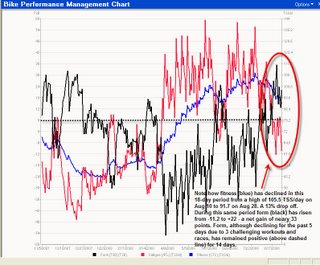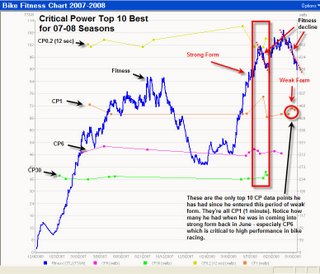Weak Form and B-Priority Races
These 2 charts illustrate what I call weak form quite accurately. The athlete has been reporting feeling rested but not powerful in his Tuesday group rides and weekend races recently. He’s at the end of his season and his last A-priority race is well behind him now. All he’s had left on the calendar were several B+ races. He wanted to do well at these which translates to “resting before each race for 2-3 days.” There is always a price to pay for rest – lost fitness. That’s what we see here in these charts.

In the first chart notice how his fitness (blue graphic) has declined in the last 18 days (the portion inside the red oval). At the start of this period on August 10 his TSS/day was 105.5. That’s just below his high fitness point of the season which was at about 110 TSS/day. As of yesterday his fitness had dropped to 91.7 – a 13% loss. I’ve found that losses of 10% or less seem to be optimal when peaking. He’s outside of that range and it’s apparent.
During this same period his form (black graphic) on the first chart has risen from -11.2 to +22, a net gain of nearly 33 points. Form, although declining for the last 5 days due to 3 challenging workouts and races, has remained very positive (above the dashed line) for the last 14 days.
Having positive form almost always means that the athlete is feeling rested. But if fitness drops off too much (more than 10%) power is lost. So this explains why the athlete feels ready to race but can’t seem to produce decent results. Weak form.
The second chart illustrates this in another way. It reflects his fitness (blue) for the last 2 seasons and also shows his top 10 best critical power (CP) values for 12 seconds (CP0.2), 1 minute (CP1), 6 minutes (CP6) and 30 minutes (CP30). Notice that most of his top 10s have been this season which starts at the low point in the blue fitness graphic. His best results of the season came when he was peaking for his A-priority race in June. This is the area within the red rectangle. Notice how many top 10 CPs occurred then. This was very definitely a period of strong form. He lost about 10% of his fitness then but was putting out some of his best power of the season, especially at CP6 which is critical to success in bike road racing. Also note how few top 10s he’s had during this recent period of time described above. Only 3 and they were all at CP1.

This is why I tell athletes that they need to limit the number of A- and B-priority races they do in a season, and preferably spread them out. Resting every week to have good results ultimately means having poor results. Keep this in mind as you start thinking about your race schedule and priorities for the 2009 season.

In the first chart notice how his fitness (blue graphic) has declined in the last 18 days (the portion inside the red oval). At the start of this period on August 10 his TSS/day was 105.5. That’s just below his high fitness point of the season which was at about 110 TSS/day. As of yesterday his fitness had dropped to 91.7 – a 13% loss. I’ve found that losses of 10% or less seem to be optimal when peaking. He’s outside of that range and it’s apparent.
During this same period his form (black graphic) on the first chart has risen from -11.2 to +22, a net gain of nearly 33 points. Form, although declining for the last 5 days due to 3 challenging workouts and races, has remained very positive (above the dashed line) for the last 14 days.
Having positive form almost always means that the athlete is feeling rested. But if fitness drops off too much (more than 10%) power is lost. So this explains why the athlete feels ready to race but can’t seem to produce decent results. Weak form.
The second chart illustrates this in another way. It reflects his fitness (blue) for the last 2 seasons and also shows his top 10 best critical power (CP) values for 12 seconds (CP0.2), 1 minute (CP1), 6 minutes (CP6) and 30 minutes (CP30). Notice that most of his top 10s have been this season which starts at the low point in the blue fitness graphic. His best results of the season came when he was peaking for his A-priority race in June. This is the area within the red rectangle. Notice how many top 10 CPs occurred then. This was very definitely a period of strong form. He lost about 10% of his fitness then but was putting out some of his best power of the season, especially at CP6 which is critical to success in bike road racing. Also note how few top 10s he’s had during this recent period of time described above. Only 3 and they were all at CP1.

This is why I tell athletes that they need to limit the number of A- and B-priority races they do in a season, and preferably spread them out. Resting every week to have good results ultimately means having poor results. Keep this in mind as you start thinking about your race schedule and priorities for the 2009 season.


7 Comments:
Joe, Thank you for another interesting post. What would be optimal spacing between A-priority races? Rick
Rick--Good question. As with most everything, "it depends." The lots of variables but let's just two of the most obvious--how long the taper was and how stressful the race was.
The longer the taper before the first A race, typically the more time that will be required to rebuild race fitness. And the more stressful the race was 9such as an IM) the more time that's needed.
So in these cases I'd say the answer to your question of the optimal time gap would be around 15 weeks. That's unlikely for most triathletes and cyclists so I'd propose that the minimum in this situation in which i'd still be confident of success is 9 weeks. That may not be likely either. So bare bones would make it 6 weeks. I would not be confident of success with this but that's part of the challenge of training--how best to take advantage of sparse training resources to get maximal results.
HI Joe-
A few questions for you.
1) I followed the 10% rule for my last A priority race and found that it possibly left me a fatigued on race day. Do you feel that being glued to the 10% rule can cause an athlete to do too much in the taper?
2) What are you using as your CTL and ATL constants? I have 2 charts right now. 28/7 and 45/7.
3) Are the charts based on cycling data only?
3) Do you think that the 10% rule applies mostly to athletes that follow training blocks similar to what you recommend(rest each week)? Longer, more intense training blocks may take longer to "unload."
Blake--Peaking is certainly at least as much an art as a scince, although it's becoming more forumlaic it seems. But there will always bethose for whom something different works better. So with that in mind I'll take a stab at your questions...
1) I've yet to have an athlete have a good race with weak form. But I've only been using this method for 2 seasons. I still have a lot to learn
2) 42/7 unless I find a reason to alter that.
3) Yes.
4) I can't speak for how to peak when using a different peridoization scheme than what I use. It may require something altogether different in that case.
Just curious as to which type of periodization this athlete is following.
Thanks,
JP
Thanks Joe...much appreciated response!
JP--Linear/classic
Post a Comment
<< Home